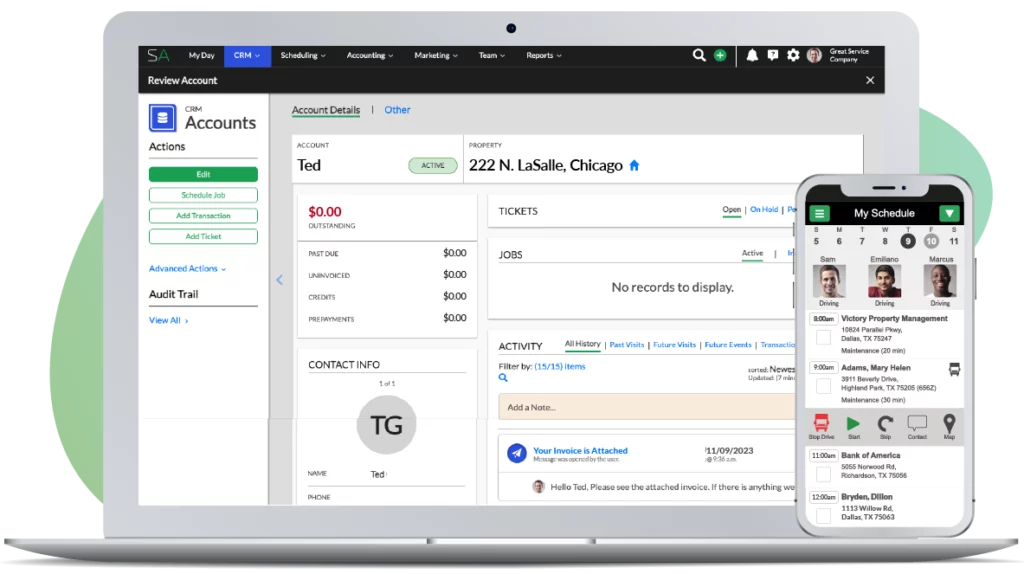In this video, Mike shares how he has successfully been able to prevent recruiting bottlenecks in the toughest times of his business.
Jonathan: Hey, Mike. How’s it going?
Mike: Good, Jonathan. How you doing?
Jonathan: I’m great. Hey, thanks for doing this. I know you’re leading a super crazy busy life these days, with what? You have two kids now?
Mike: Yeah, two kids. One nine weeks and the other one, 18 months.
Jonathan: That’s awesome. That’s awesome. Plus you’ve got your two companies, so you’re a busy guy. Thank you for doing this.
I definitely wanted to ask you a couple questions, because from knowing you now for a number of years, you are absolutely getting stuff done. If you would, tell us a little bit about just real quick, who are you? What are you doing so everybody knows you?
Mike: Yeah, absolutely. Started out like many of the people probably listening, freshman year in high school, pushing a lawn mower around the neighborhood to pay for the car insurance, ended up five years at college and evolving into a full-time lawn care and shell removal company in the Northeast. Currently employing twenty-two to twenty-five individuals. In addition, I’ve started a secondary company that focuses on business automation and sales marketing, as well as employer recruiting training.
Jonathan: Perfect, that’s one of the questions that I wanted to ask you. I know that you just recently had an event in your company where all of a sudden you had to absorb a lot of new work. Which meant that you had to go find a bunch of people. Then I also know that you work with a lot of other companies, so you have a lot of ideas that aren’t just things that you figured out running you own company. You’ve figured them out by helping other people. Specifically, tell us all about the event you just had that resuscitated the need to go find a whole bunch of people real quick. With that, give us some clues on how we could solve our recruiting problems because I think that’s what … That’s the big bottleneck that most of us are having.
Mike: Yes, it seems like in my company what we bitched about and talked about is how to find qualified employees who will even show up to an interview, let alone show up to the first day of work and do quality work and be dedicated to your mission and values that you are trying to do. Long story short, one of our subcontractors, their child had some health issues. He had to actually fly back to where they’re from for some treatments. Gentleman in good faith, since we had taken care of him as a subcontractor, handed over a sizable amount of lawn mowing contracts on short notice obviously with the health issues of this child. We basically grew by 17% within a matter of three or four days. Which you’re wondering how that would actually happen not having the wheels fall off. The company had to go out and fill those jobs and grow by 17% overnight pretty much.
The key to that success that we found prior, to allow that acquisition to happen naturally, pretty much flawlessly, and be able to absorb that many accounts is the ability to go out and recruit employees. I like to use the analogy of stacking the bench almost like a sports team. What we constantly do is we interview in our company every Monday, Wednesday, and occasionally Fridays for every position in the company, including my own. The reason why we do that is because we want the ability to not pick the first applicant that comes in the door if we have to fill a gap. Now that we pre-qualify these employees and actually stack the bench per-say, we can rate them in an A, B, and C level with or without a license. If we are looking for a crew leader with a license, we have a database of qualified people that were interviewed the last month or two who would fit that position.
This gives you some leverage in the field with your staff because I know their constantly … You know, their job is online as far as if they are not producing, and if they don’t have you over the barrel per-say and threaten you to quit when you don’t have anybody to replace them. That was a major issue. We started growing our business. The guys knew they had us basically bent over the barrel if they wanted a pay raise or if they weren’t producing. They knew that we couldn’t really do anything to replace them.
In order to grow the business, we really needed to have people that bought into our core values and mission. We wanted to hire to the culture that we built in the company. The best way to do that was to be constantly recruiting for every position. In addition, that would basically keep the guys on the field if you have a major spike in sales, especially Northeast where you may grow fifteen to twenty percent in a matter of a month. You basically have that waiting staff that is ready to go and that is qualified, where you can actually call on them.
I hope that makes sense. We are prophylactic hiring.
Jonathan: It makes perfect sense. Are you running ads all of the time or do you have a couple really successful ways to keep the funnel loaded with potential people to interview?
Mike: Yes, there are two or three things that are very key that we try to use. The first thing that we do, is that if we have a core group of employees in the field or even in the office that we know that we really like their work ethic and what they believe in, we’ll actually do a referral bonus of $250 for anybody that they refer that stays with the company more than six months. That’s allowing us to go out and find people who are like-minded, hopefully with the same work ethic right off the bat.
The secondary thing is that we hit major channels such as Indeed, Craigslist, a couple other online sites where we actually have a two to three step automated interviewing process where they have to jump through multiple hoops before they get to our office. We are pre-qualifying the applicants before they get to the interview. Then once they get to the interview, we run them through an automated training series of videos with questions to actually make sure they’re going to be a good fit for the position, you know, until they actually get to the field. If they are a good fit, we’ve already set them in motion with set processes and procedures of how we do everything. So when they get into the field, we are not just handing them a weed-wacker, telling them hop on a lawn mower, and go do the job. It’s helped with our retention.
At the end of the day, we’re selling our company to the prospective employee, as much as they are selling themselves. In order to go out and get a super star employee, at least my feeling is you really need to sell your company as a great place to work and an environment that they want to be in and actually want to go to. It’s not just a job. It’ll be a career. We want them to buy in to what we are actually trying to achieve.
Jonathan: For somebody that says that this all sounds awesome, I’d love to do that, but I’m so busy that I just don’t have the time to work on recruiting or I don’t have the time to do anything that you mentioned, what would you suggest? How did you get started? Is there a small baby step to start moving in this direction.
Mike: I think that even if you don’t have the time and you’re … You know, for a lack of better words, still on the truck as a technician that’s still running the business. We’ve all been there, so I know me standing on a pedestal saying that I haven’t been there and my managers are going to get back on the truck to fill some gaps. I think that the only way that you can be successful, at least get your life back from constantly plugging the gaps and being in a tight spot. That’s the one thing I hear from hundreds of contractors throughout the year, “We just can’t grow our business because we can’t find quality applicants. There’s just nobody that’ll show up for an interview.”
Part of the problem is that you need to block out a few hours a week. It’s just as important as getting the work done in the field as it’s important to building it out. You need to start working on building a staff that can support you, get you out of the field if that’s your goal. Even if your goal is to stay on the truck, which is perfectly fine depending on the size of business what you want to get out of it, you still in my belief you really need to spend two to three hours a week, or even an hour, working those hours first thing in the morning or over the weekends and interviewing those candidates. Whether it is phone interviews …
As soon as you stop being proactive about that, that’s when you’re going to get yourself in trouble. Even if you are a two man operation and you need a technician with you running in the truck, you are in a major pickle if that person leaves or gets hurt. You have no back up. It’s just you then. You have to proactively be recruiting no matter what size you are, in my opinion.
Jonathan: Oh man, I 100% agree. In all the different businesses that I’ve now been part of building and I think back, I didn’t have this revelation until really the last few years. Now, kind of putting all of the puzzle pieces together and looking back at all of the businesses, every one of them universally … And I’ve been in cleaning and lawn care and software, healthcare, been in these different industries. Every one of them universally has the exact same problem, it’s people. It’s the bottleneck of every company. It’s the slowdown. Once you figure out the basic core marketing, it’s the number one problem that everybody has. Yet, none of us are spending the majority of our time and effort on it.
I’m so convinced that it’s the hindrance to most growth that I believe the number one job of the CEO is to, and you eluded to this, but the number one job of the CEO is to be recruiting, to be building the team, making sure you have the right people on the team. You know the old saying, “You have the right people in the right seats on the bus.” … Basically doing the right job, and that you are getting rid of the wrong people so they don’t destroy your culture. And that they are following the vision that you have the people … Again, all of the stuff you sort of said. I believe to my core that it is the most important thing. Your most important charge. It starts when you are little bitty, and it never ends as you grow the company to whatever size.
Mike: Just as you are starting out, growing, and scaling, one of the things that I find very helpful is we’ve got an organizational chart of all of the positions and all the responsibilities. You may be wearing the hat of maybe several positions at this point, but it starts with a goal of three to five years. I predict considerably like three years out. Build what that work chart is going to look like, so you are not immediately trying to hire for the positions that you had, but you are starting to build a leadership team or a management team around what that future team looks like.
As you are going out recruiting and constantly interviewing these people two to three times a week, if there is an individual that stands out say, “Hey, maybe this guy will be a perfect fit for that position I have two years down the line.” You may be able to work it in your budget that’s just the ideal candidate because if you are not actively looking and knowing what you need down the line to be successful, it’s too late when you need to do it immediately.
Jonathan: Great advice. I’m wondering if this is your approach or if you have a better or different way? Basically what we’ve done is exactly what you’ve said in terms of thinking about “Okay, here are the positions.” In other words, here are the different hats that need to be worn throughout the organization in terms of what the company will look like if we hit our goal and our vision in three years. Imagine that you have that. That’s what I think you are saying. Are you then putting names to this right now. Saying, “Okay, Mike’s wearing this hat, this hat, this hat. I’m filling all of these positions.” Are you going that far with it and identifying who’s in each of the roles now? Then thinking too, Mike, meaning you, “I’m in this role, this role, and this role, and I need to get Mike out of all of these roles so Mike is just doing this one thing.” Do you think about it that way or is it nothing more than just identifying what you might need in terms of positions out in the future so that your mind is zeroed in and focused on that?
Mike: No, Johnathon, you actually nailed it. I mean internally what’s going on in our company is … In the lawn care company right now as it is, is that I have no desire to be involved in the day to day operations within three to five years. Right now in the present company, there are some functions that I’m doing and wearing multiple hats, as well as my manager, so we built out our organizational chart for today, but my managers may be doing sales and marketing and he may be doing quality control and he may be the direct report for one of the two admins.
At scale as we grow three to five years, they are going to be separate individual roles with a specific measurable targets. For instance, our quality control person would be literally … Their whole matrix and what we are going to base them on is literally customer retention, and quality control and making sure the crews are working off what the processes consist of. Right now, obviously, we are not up to scale where we can have a dedicated quality control. So that manager is quality control, part-time sales person, part-time trainer as far as the guys in the field. Each one of those positions is dialed out and that person is listed at each spot. We know right now who is being held responsible to each one of those goals that at scale as we grow we know that’ll be a separate position.
Jonathan: Thanks for that. That’s fantastic advice.



